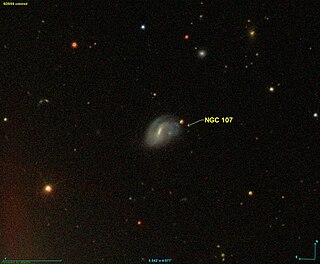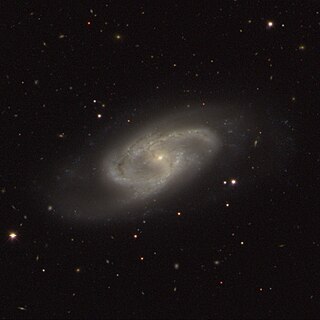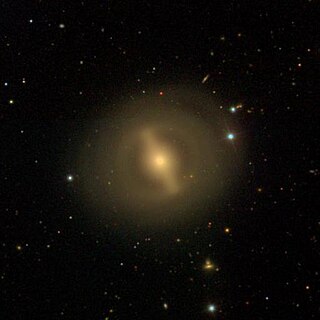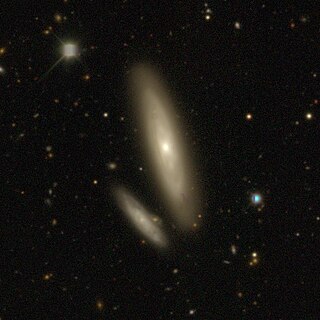
The Collinder catalogue is a catalogue of 471 open clusters compiled by Swedish astronomer Per Collinder. It was published in 1931 as an appendix to Collinder's paper On structural properties of open galactic clusters and their spatial distribution.

NGC 51 is a lenticular galaxy in the constellation Andromeda. It has a diameter of 90,000 light-years. The galaxy was discovered on September 7, 1885, by Lewis Swift, who described it as "Pretty faint, pretty small, round, brighter middle."

NGC 72 is a barred spiral galaxy estimated to be about 320 million light-years away in the constellation of Andromeda. It was discovered by R. J. Mitchell in 1855 and its magnitude is 13.5.

NGC 101 is a spiral galaxy estimated to be about 150 million light-years away in the constellation of Sculptor. It was discovered by John Herschel in 1834 and its magnitude is 12.8. It is a member of the Southern Supercluster the closest galaxy supercluster to the Local Supercluster.

NGC102 is a lenticular galaxy estimated to be about 330 million light-years away in the constellation of Cetus. It was discovered by Francis Leavenworth in 1886 and its apparent magnitude is 14.

NGC 105 is a spiral galaxy estimated to be about 240 million light-years away in the constellation of Pisces. It was discovered by Édouard Stephan in 1884 and its apparent magnitude is 14.1.

NGC 106 is a lenticular galaxy estimated to be about 270 million light-years away in the constellation of Pisces. It was discovered by Francis Leavenworth in 1886 and its apparent magnitude is 14.5.

NGC 107 is a spiral galaxy estimated to be about 280 million light-years away in the constellation of Cetus. It was discovered by Otto Struve in 1866 and its magnitude is 14.2.

NGC 109 is a spiral galaxy estimated to be about 240 million light-years away in the constellation of Andromeda. It was discovered by Heinrich d'Arrest in 1861 and its magnitude is 13.7.

NGC 1245 is an open cluster in the constellation Perseus. It was discovered by William Herschel in 11 December 1786. It is located 3° southwest of alpha Persei and can be spotted with 10x50 binoculars. The cluster is nearly 1 billion years old. NGC 1245 has about 200 members the brightest of which are of 12th magnitude. The cluster shows evidence of mass segregation and it is possible that it has lost its lower mass members. Lying at a distance of 3kpc, the cluster is estimated to be 27 light years across.

NGC 150 is a barred spiral galaxy in the constellation Sculptor. It is about 70 million light years away from the Solar System, and it has a diameter of about 55,000 light years. It was discovered on 20 November 1886, by Lewis A. Swift.

NGC 259 is a spiral galaxy located in the constellation Cetus. It was discovered by William Herschel in 1786.

NGC 422 is an open cluster located in the constellation Tucana. It was discovered on September 21, 1835, by John Herschel. It was described by John Louis Emil Dreyer as "very faint ", with Nubecular Minor being the Small Magellanic Cloud. It was also described by DeLisle Stewart as "only 3 extremely faint stars, close together, not a nebula."

NGC 426 is an elliptical galaxy that is also classified as a Seyfert galaxy. It is located in the constellation of Cetus, and it was discovered on December 20, 1786, by William Herschel.

NGC 4608 is a barred lenticular galaxy located in the constellation of Virgo. The galaxy was discovered by astronomer William Herschel on March 15, 1784. At about 56 million light-years away, it is a member of the Virgo Cluster.

NGC 4429 is a lenticular galaxy located about 55 million light-years away in the constellation of Virgo. NGC 4429 is tilted at an inclination of about 75° which means that the galaxy is tilted almost edge-on as seen from Earth. NGC 4429 was discovered by astronomer William Herschel on March 15, 1784. The galaxy is a member of the Virgo Cluster.

NGC 4606 is a spiral galaxy located about 55 million light-years away in the constellation of Virgo. NGC 4606 was discovered by astronomer William Herschel on March 15, 1784. It has a disturbed stellar disk suggesting the actions of gravitational interactions. NGC 4607 may be a possible companion of NGC 4606. However, their redshifts differ by about 600 km/s, making it unlikely that they are a gravitationally bound pair. NGC 4606 is a member of the Virgo Cluster.

NGC 4515 is a lenticular galaxy located about 57 million light-years away in the constellation Coma Berenices. NGC 4515 was discovered by astronomer William Herschel on March 21, 1784. The galaxy is a member of the Virgo Cluster.

NGC 499, also occasionally referred to as PGC 5060, IC 1686 or GC 289, is a lenticular galaxy in the constellation Pisces. It is located approximately 197 million light-years from the Solar System and was discovered on 12 September, 1784 by astronomer William Herschel.

NGC 527, also occasionally referred to as PGC 5128 or PGC 5141, is a lenticular galaxy located approximately 259 million light-years from the Solar System in the constellation Sculptor. It was discovered on 1 September 1834 by astronomer John Herschel.




















